Previously on
A Honeymoon to Remember, this daring duo braved the elements, Bangkok traffic, and risked their very lives to savor the wondrous culinary creations at Gaggan. So was it worth it, you may ask? The answer is…. sort of. We arrived at the restaurant breathless, but within the time limit given. I only had a moment to sneak a quick pic of the restaurant’s façade before rushing in, but it really stands out from its surroundings. Gaggan is located in a narrow alleyway across from a hotel, but you could not tell from the picture. The façade evokes an old world colonial style, but with a modern edge. The old world white with the glass and metal creates a powerful first impression, and makes you look forward to what awaits. It actually reminded me of our hotel, The Siam.

Inside, we were seated in a nice alcove, and we were introduced to Vlad, who I think was the sommelier. Vlad was incredibly knowledgeable and friendly, making conversation about how a Russian ended up working in Bangkok, how he loved New York, and, of course the wine. We wanted a wine that was both light but would assert itself with each of the many different courses. We let me him know that we are big fans of Alsace whites. He recommended a great option, which we will probably be buying the near future.
I would characterize Gaggan’s menu as the ....... love child of Willy Wonka and Eric Ripert. The dishes are inventive and unique, and when they work, they
really work. However, Gaggan also toes the line between quirky and kitschy. I believe that if you are going to make the eater participate in some unique way with your course, it should add something to the meal, and not simply be something that is done simply for the sake of having it done. This is my first critique of Gaggan. Some of the dishes were presented as an ‘event’ and involved eating it in a cheesy way that detracted from the actual course itself. My second critique is precisely what we feared. Gaggan’s menu is no longer an homage to his Indian roots. It can now be best characterized as Indian-Japanese fusion. Perhaps others won’t be bothered by this change, and I appreciate that he is incorporating new techniques taken from Japanese cuisine into his cooking, but that really isn’t what we were looking for here.
Gaggan’s menu consists of 25 small distinctive courses, but the menu itself is not a menu in the traditional sense. Instead, you are given a translucent sheet filled with 25 emojis, each of which represent the course. Gaggan invites the diner to try and guess what each course is before revealing it to you. See what I mean about toe the line? Yet, in this respect we enjoyed the guessing and it made the overall experience fun, and the meal interactive.
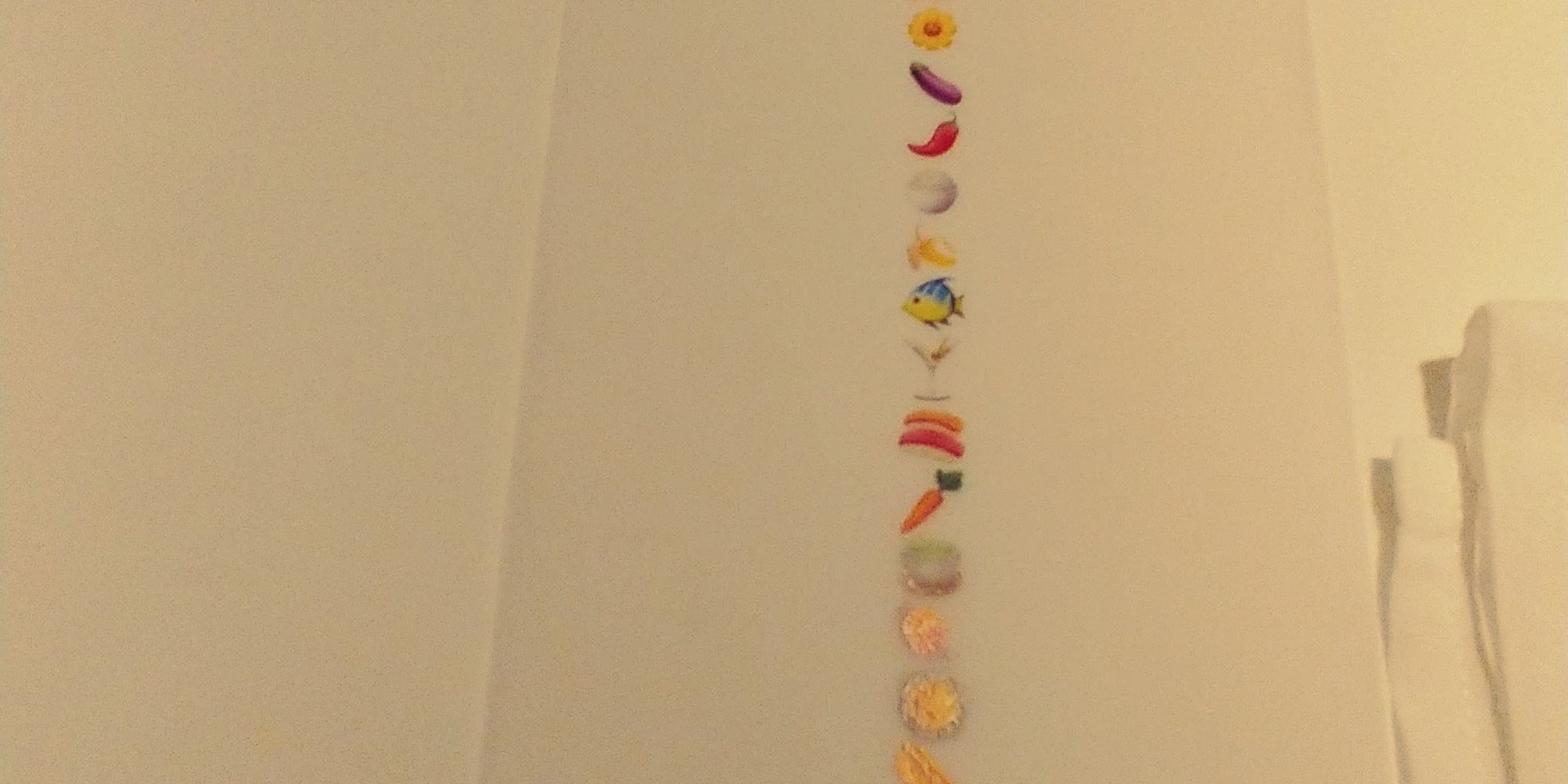
The first course had a watermelon emoji, but the plate consisted of what at first glance, appears to be an oyster with a pearl. In fact, the dish was a bright and refreshing watermelon flavored gelatin. It was a great starter and made for a powerful first impression.

Course two had an explosion emoji, and we characterized it as yogurt explosion. On first impression, the dish looks like a soft-boiled egg, and the texture was similar, but it was made of yogurt. The dish tasted like a mix between egg yolk and a lassi. It was delicious.
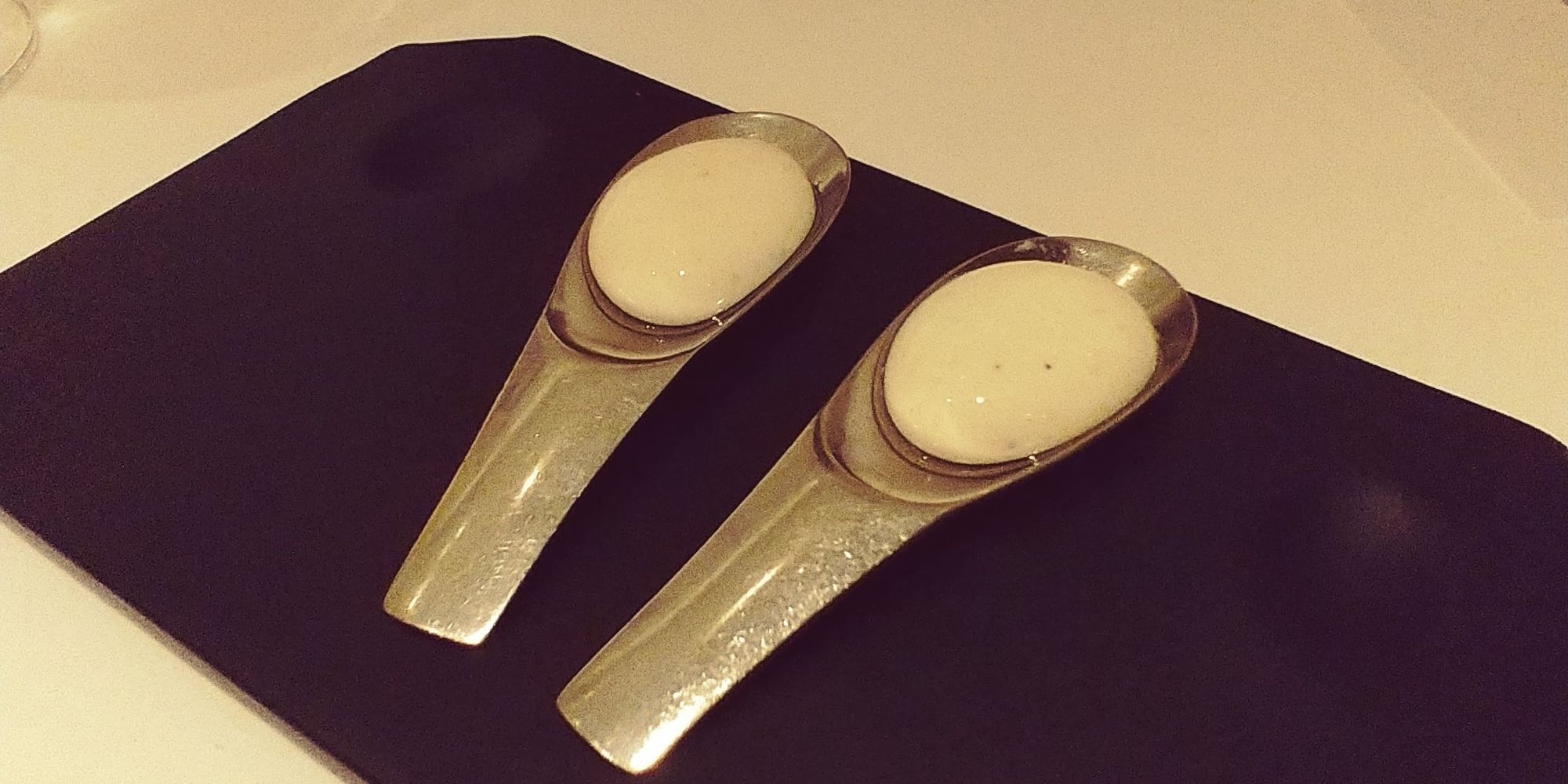
Course three is where the kitsch goes too far. The emoji consists of a tongue, and it was quite literal because we were presented with a plate of black truffle puree designed in the shape of a tongue, and the words “Lick it up” made from a pea puree. The presentation of the dish was accompanied by a small speaker with Kiss’s Lick It Up playing. Needless to say, you are meant to eat this dish by licking up the plate. The course itself was delicious, and we did not get any of the normal overt richness that normally accompanies black truffle dishes. The pea puree was herbaceous and complimented the earthiness of the truffle well. But the licking ruined it for me. It was too cute, and like I said, it added nothing to the course.
Course four had a shrimp emoji and was a play on the traditional tom yum goong. This dish was killer, and the presentation was very cool. It was a one bite, dehydrated shrimp head that ate like a potato chip, wrapped by what I can best describe as a coconut fruit roll up. There were strong notes of lemongrass and the coconut was very forward, complimenting the shrimp flavor well. For a one biter, all the flavors of tom yum goong were prevalent.
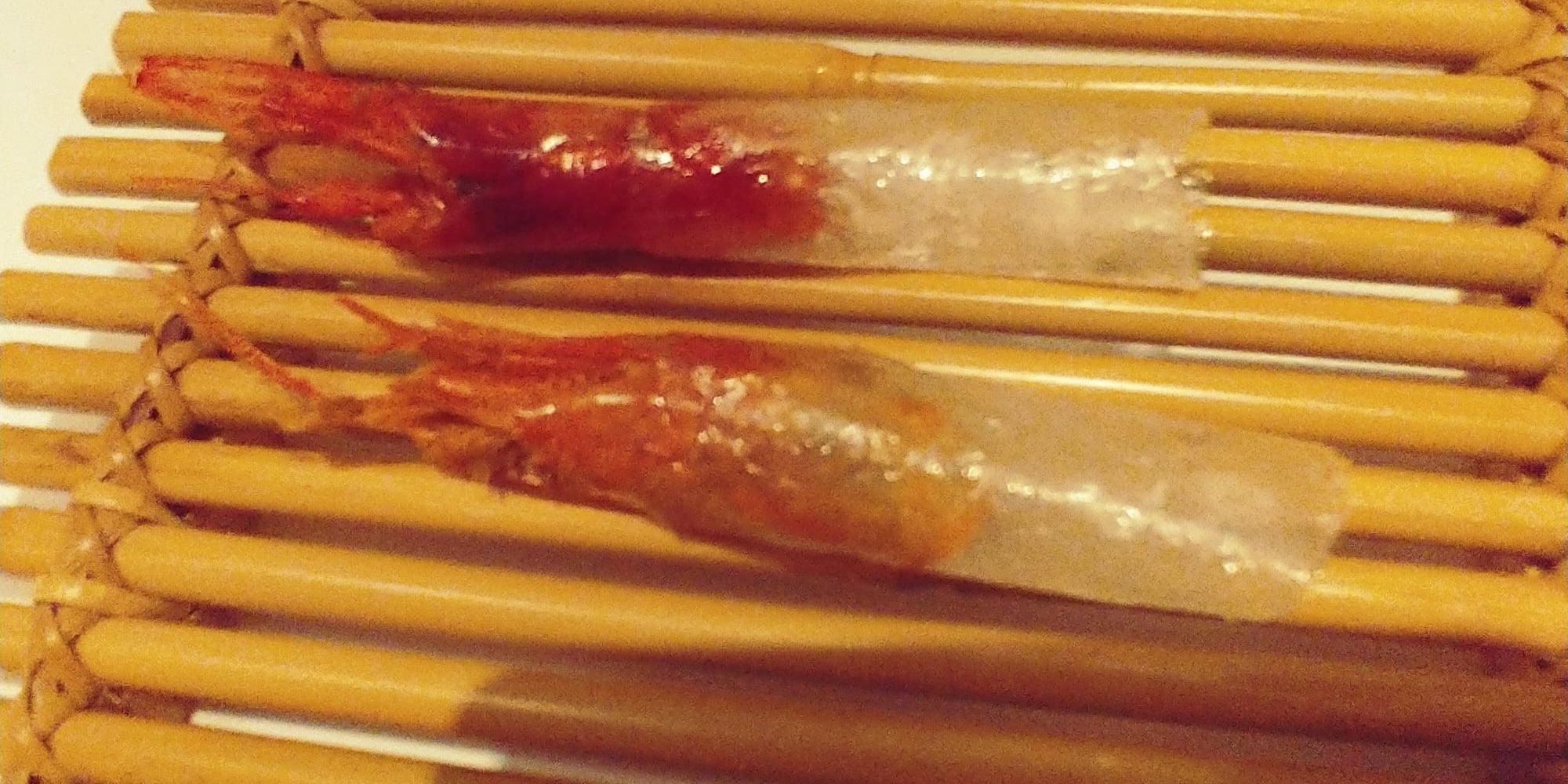
Course five had a flower emoji and was nicknamed “flower power.” The reveal stated “goat brain” but we tasted curry with hints of avocado. The texture was crunchy and similar to a rice cake.

Course six and seven were served together and had an eggplant and chili emoji. The eggplant course was an eggplant
tart, made with eggplant and garnished with powdered burnt eggplant. The eggplant was prevalent, but there was a strong sweetness that I think fought with the seventh course, the chili. The chili course was a white chocolate bonbon with a chili pepper liquid inside. It was more sweet than spicy, and had this been served on its own at the end of the meal, it would have been great. But there was simply too much sweetness going on here.
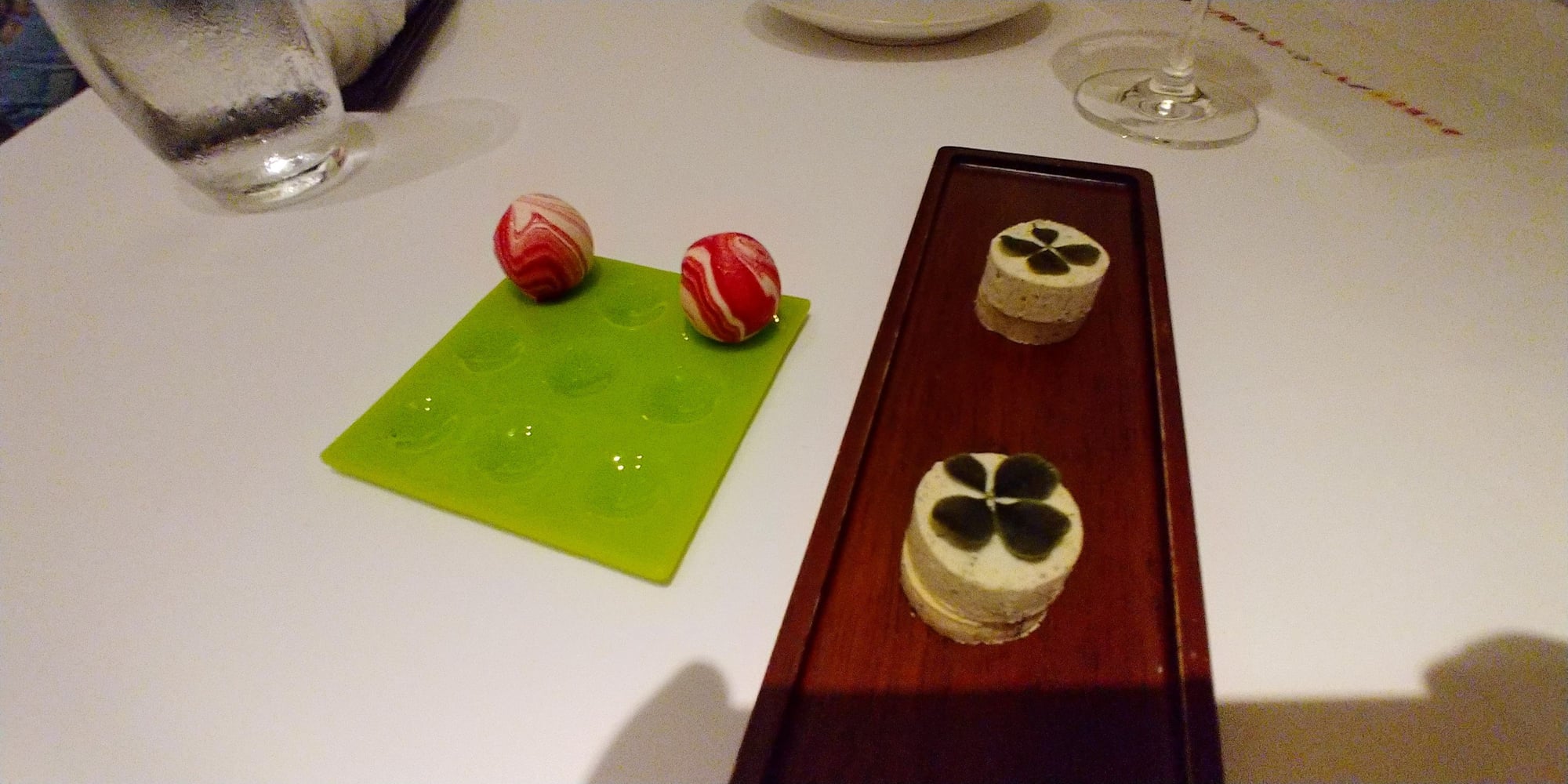
Course eight had a rice emoji, and consisted of a rice sponge cake with an Indian curry foam. This was very innovative and delicious, tasting almost identical to a yellow curry with rice.
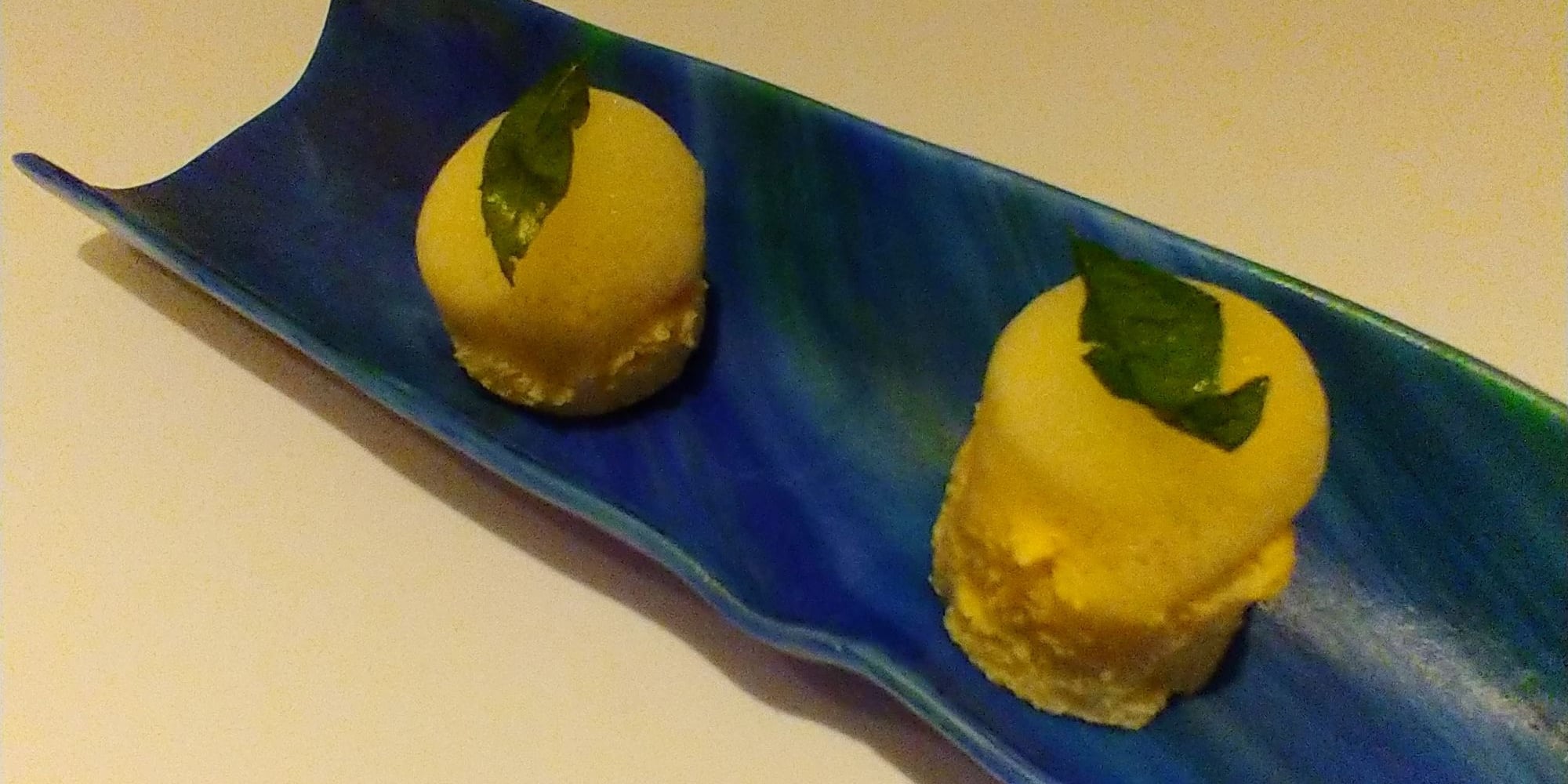
Course nine had a banana emoji and consisted of a torched banana cake with a foie gras mousse. The sweetness of the banana played well with foie gras,
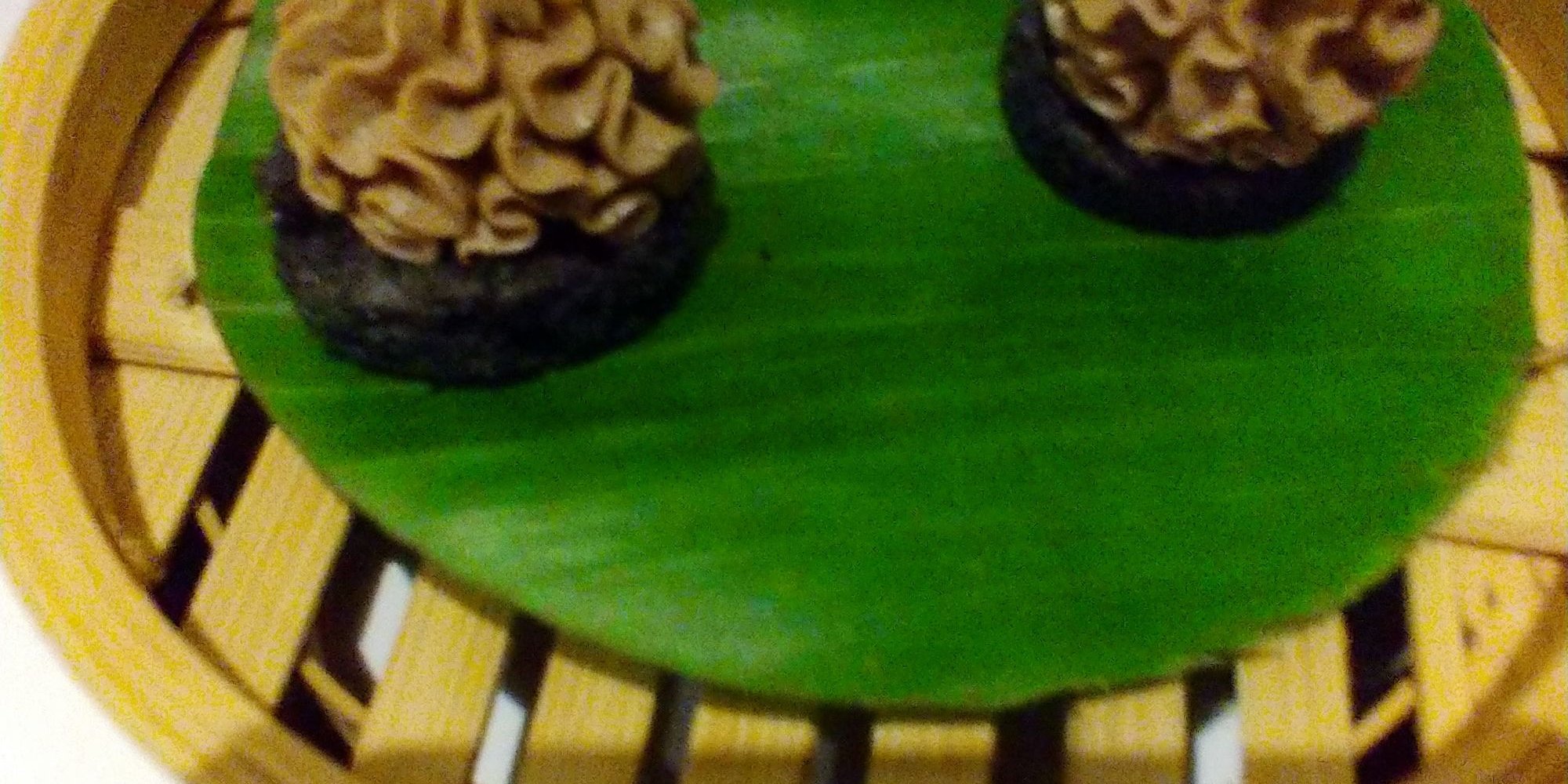
Course ten had a fish emoji and was a play on granola bars. The dish consisted of granola and sea bass, and tasted of milk and fish, but it was surprisingly well balanced and enjoyable.

Course eleven had a martini glass emoji and was a play on a gin and tonic. It consisted of horseradish ice cream with a gin and tonic foam and a dill cone with uni. Here, the chef could have used a little restraint as I felt there was a too much going on. The flavors paired well, but it the uni slightly overpowered the other more subtle notes.
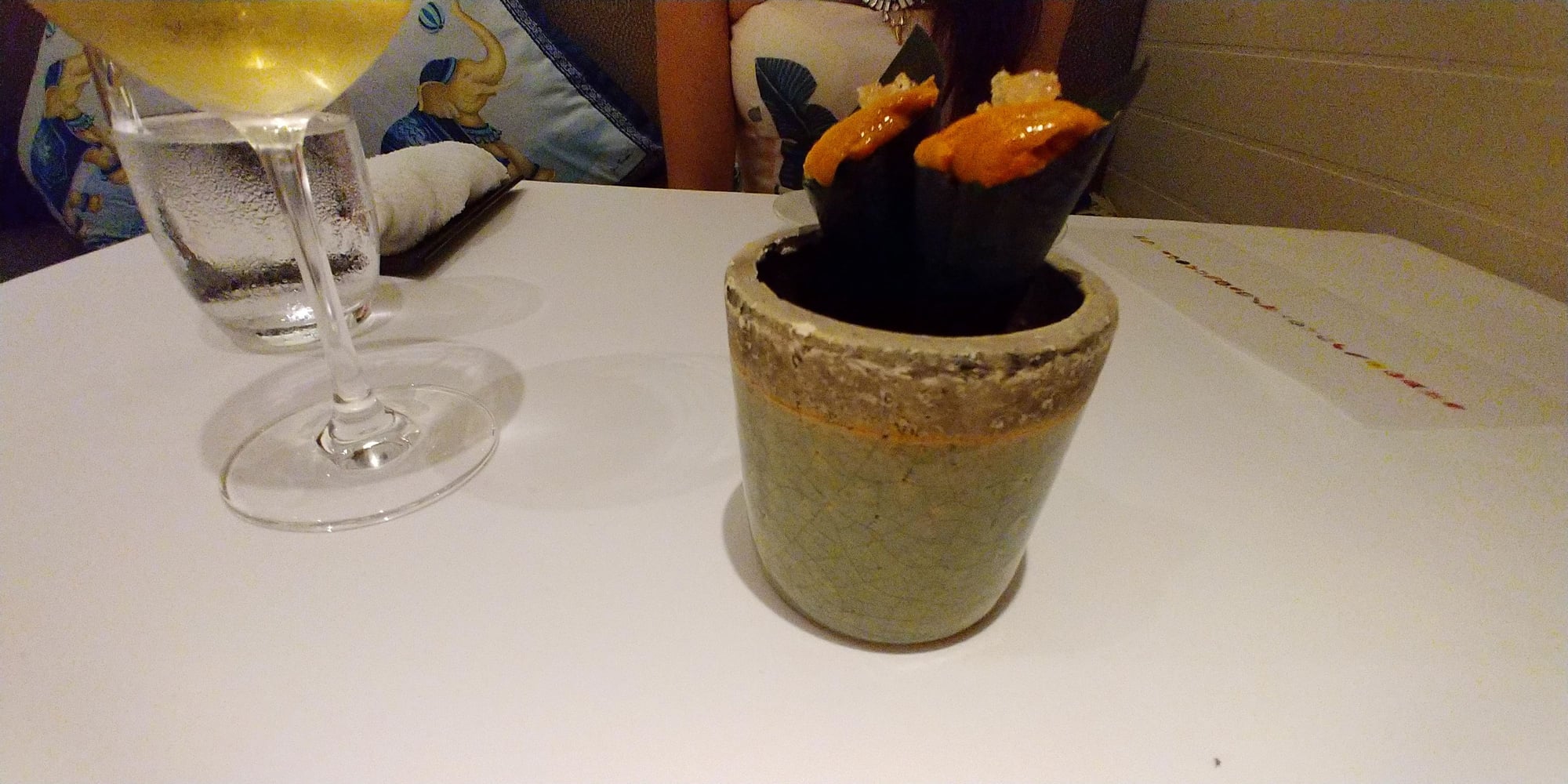
Course twelve had a sushi emoji and consisted of medium fatty tuna with a dashi meringue and wasabi. This is evidence of my point about the Japanese fusion. This was a tasty dish, but I just don’t think it went well with the theme of the courses. It just sticks out in an obvious way, giving the impression that the chef just wanted to throw in some Japanese.
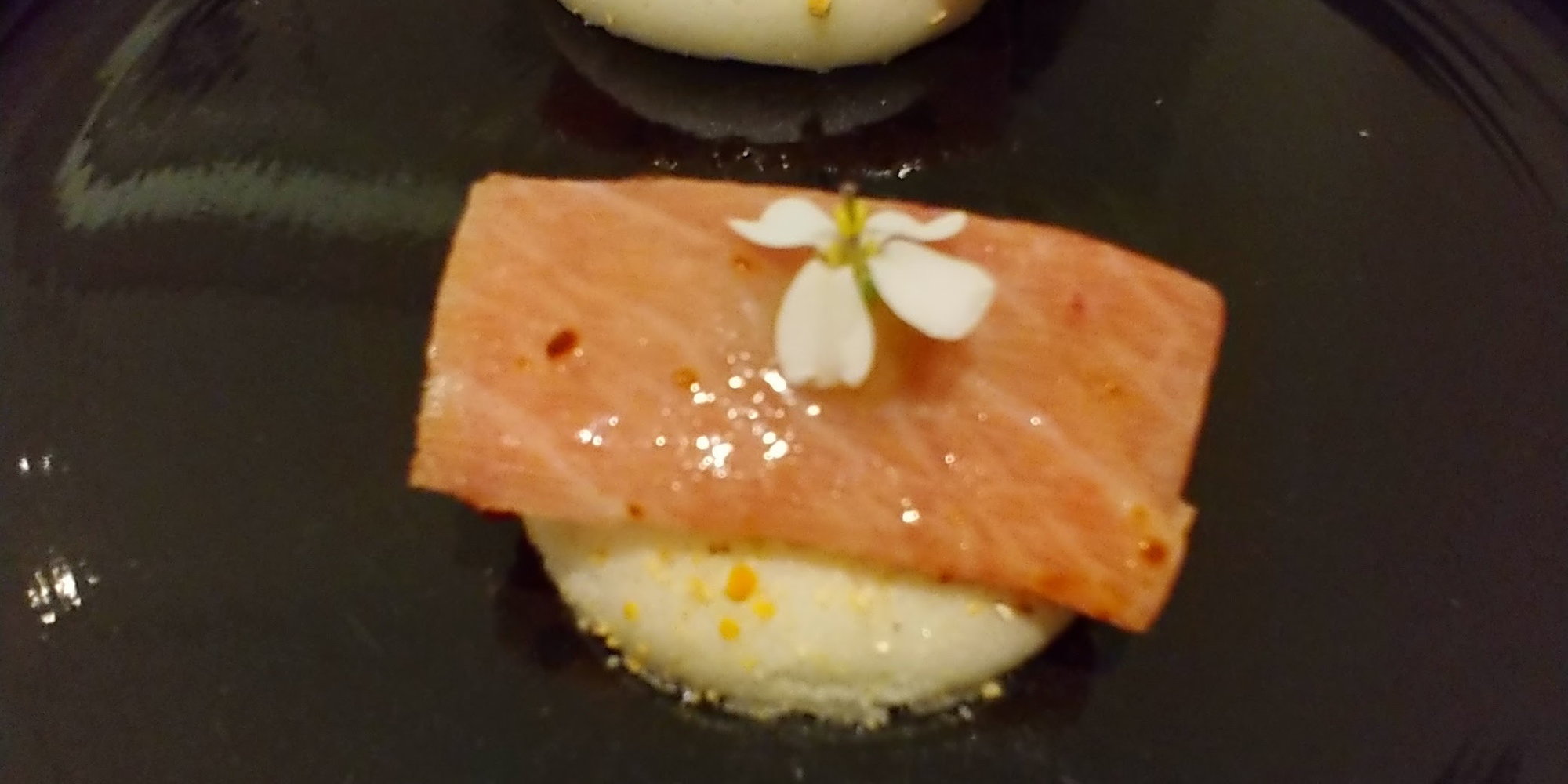
Course thirteen had carrot emoji and consisted of a carrot “waffle” with a foie gras cream filling. The waffle was sweet and crispy and paired well with the savoriness of the foie gras.

Course fourteen had a green tea emoji and was the chef’s take on a traditional Japanese matcha green tea serving. This was interesting in that the waiter came out and performed a similar ceremony to what is typically done in Japanese matcha green tea ceremonies, but the “matcha” consisted of green tomato, apple, and celery. Floral and herbaceous, this dish worked as a great palate cleanser, and contrasted well with the overall heaviness of the other course.
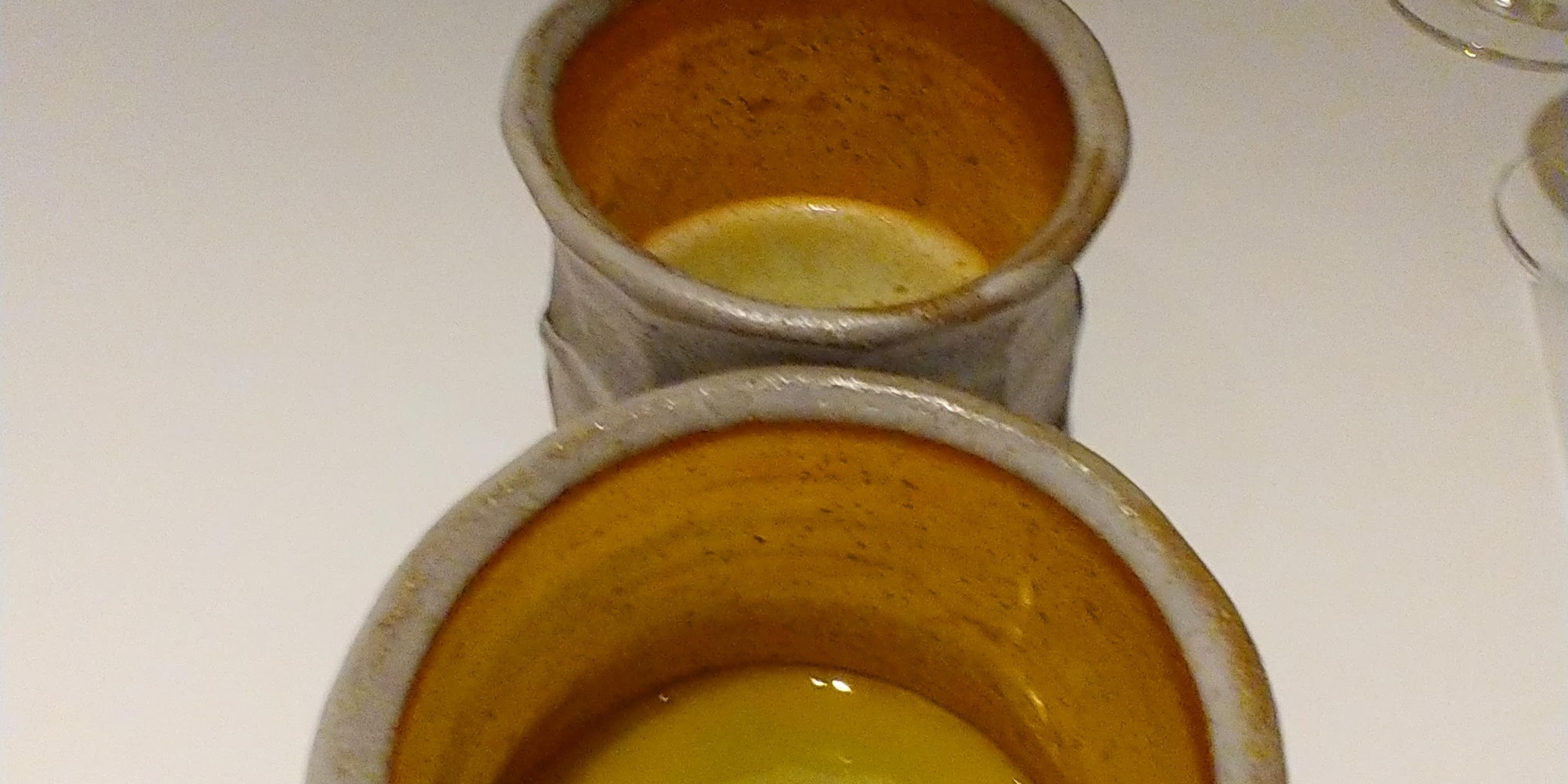
Course fifteen had a pork emoji and consisted of a deep fried curry pork tempura with Japanese mustard.
Course sixteen had a stew pot emoji and was the chef’s take on a curry. It consisted of a coconut ice cream curry, with a hot red pepper curry, served atop a raw scallop.
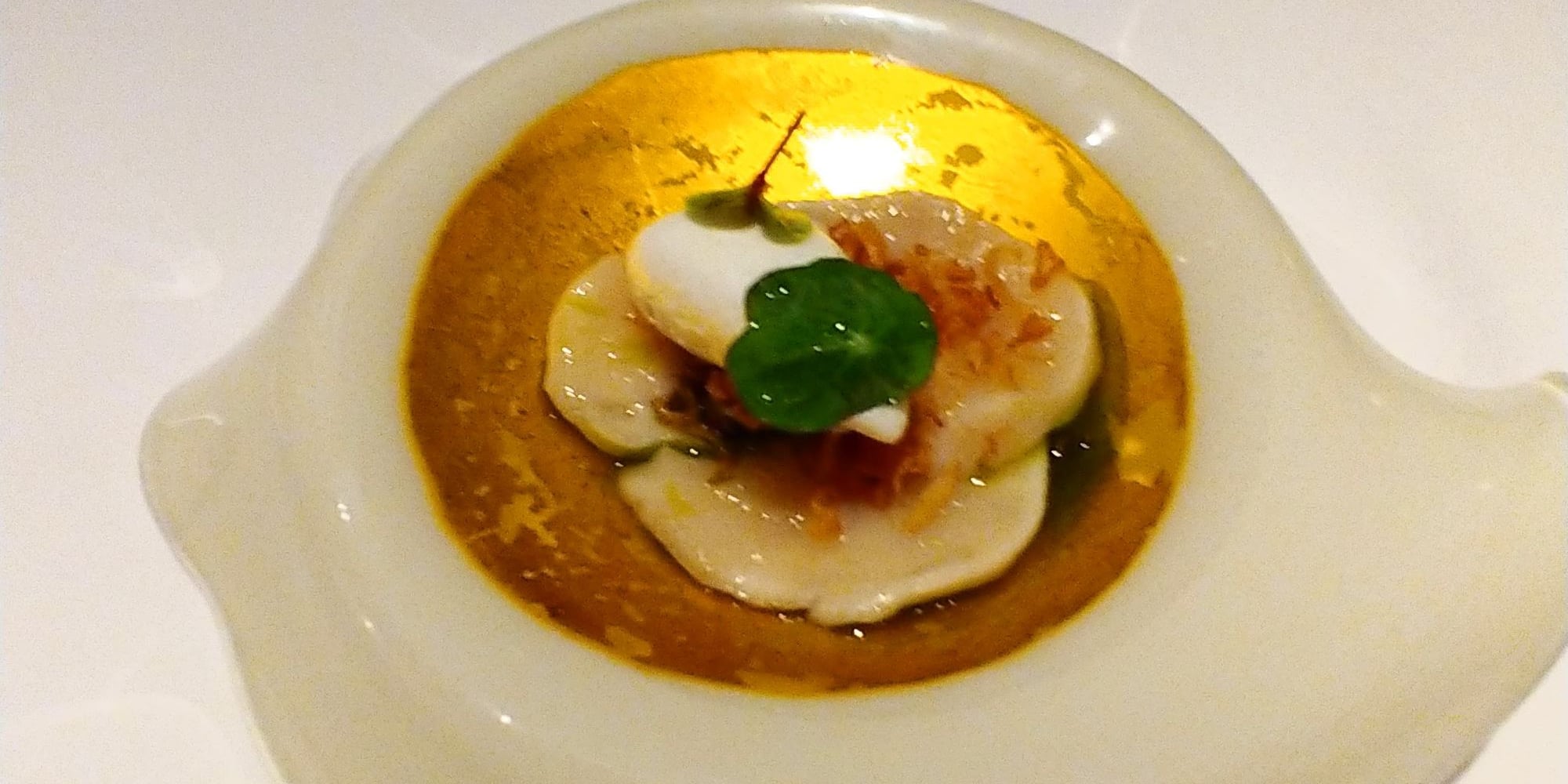
Course seventeen was a hot dog emoji and was a play on mango chutney. The dish was plated like a hot dog frank inside a potted plant. It consisted of a heavily spiced lamb, cooked in a mango leaf. I am not sure why it was served in a potted plant, but it was interesting. It tasted exactly like a mango chutney.
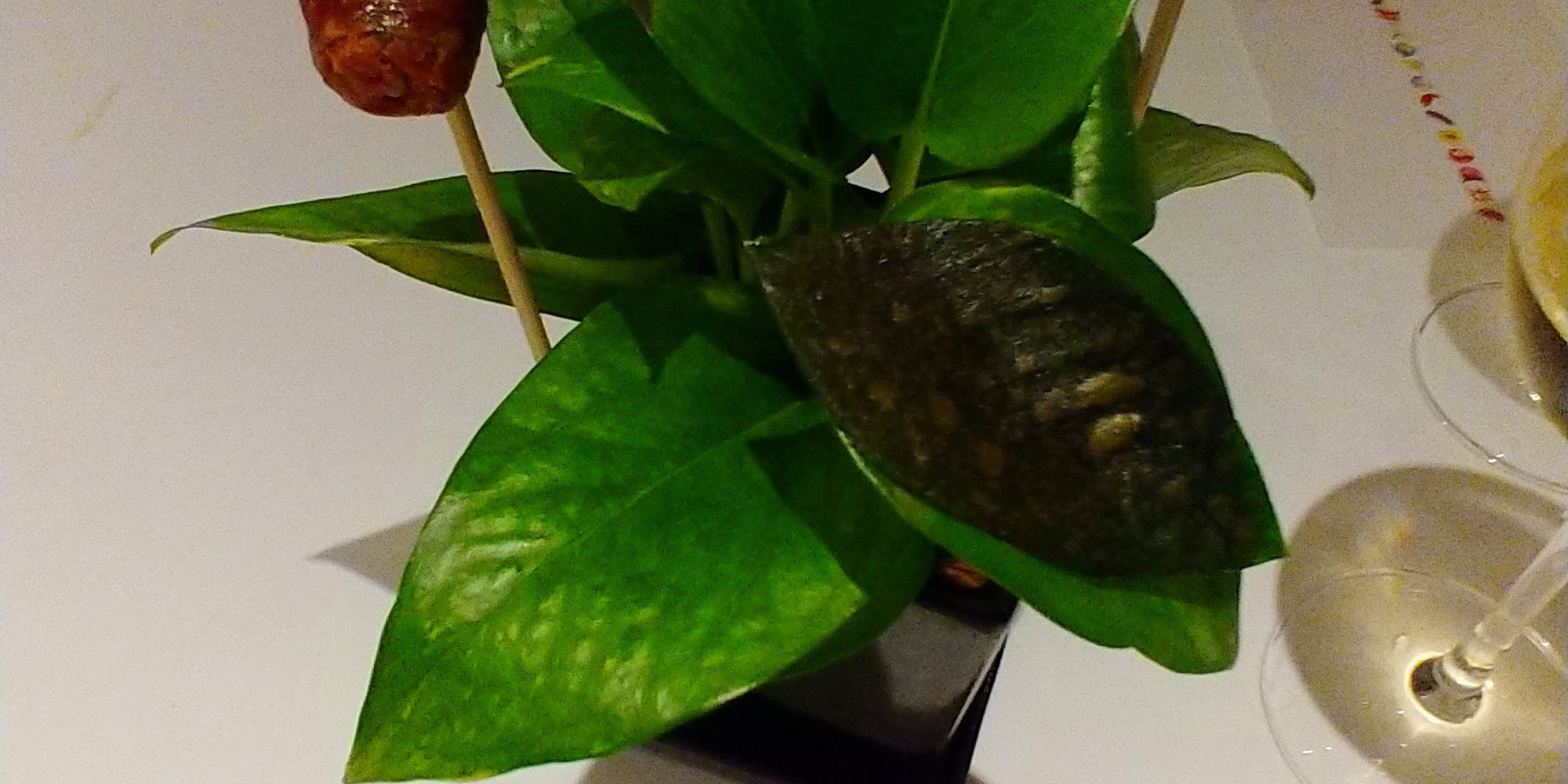
Course eighteen had a chicken emoji and consisted of fried chicken skin flavored like thai green curry.
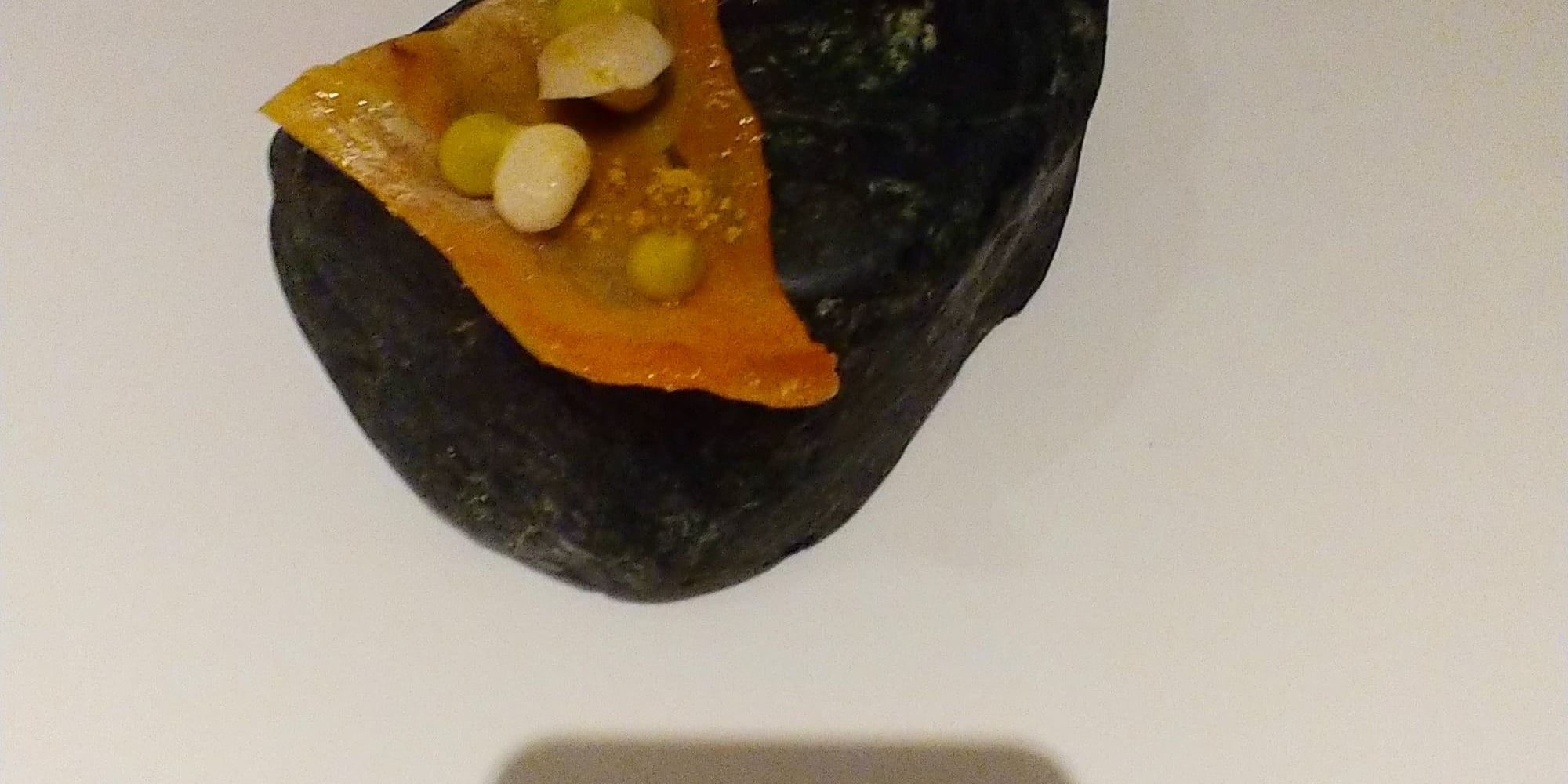
Course nineteen had a fire emoji and was Gaggan’s mother’s recipe. The dish was sea bass cooked in a banana leaf with cilantro and wasabi. The wasabi was perfectly balanced and not overpowering, but there was a slight rolling heat towards the end. With the other bold flavors throughout the meal, this dish contrasted well in that it was lighter and more subtle in flavor.
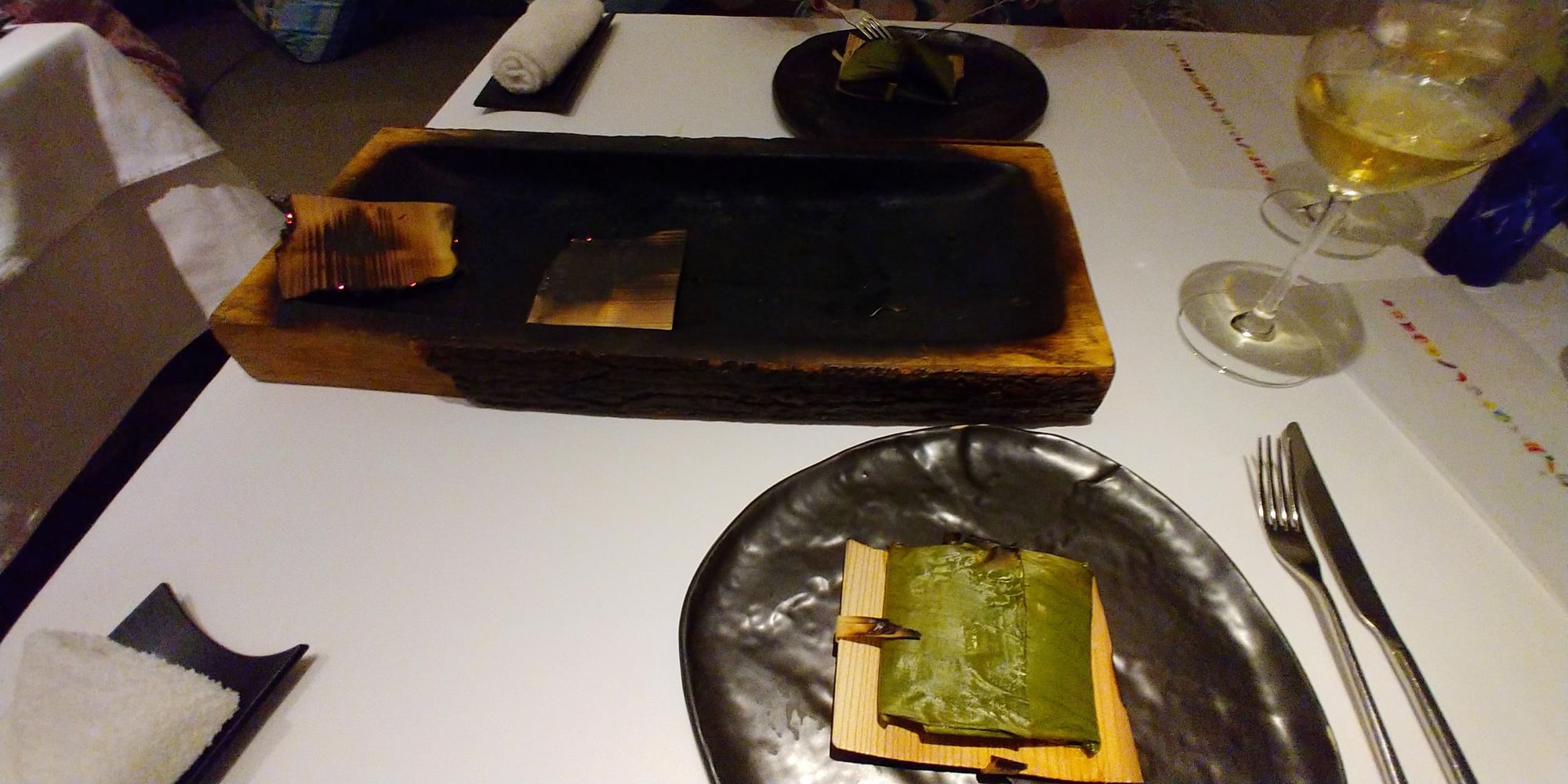

Course twenty had a charcoal emoji and was a crispy lotus stem. The taste was reminiscent of lentils or a good samosa, but slightly more floral.
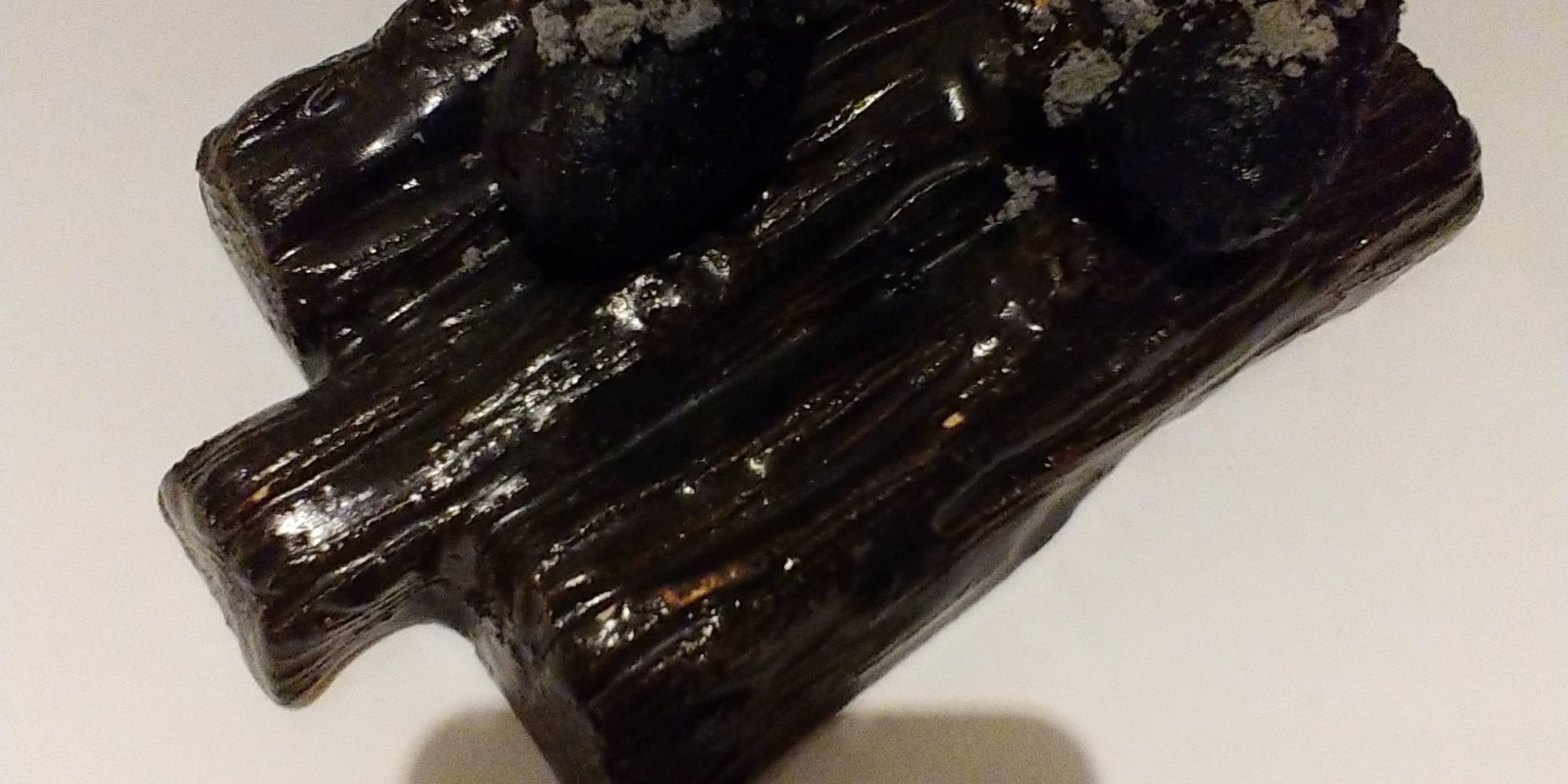
Course twenty-one had a taco emoji and consisted of a lobster curry with young coconut and coriander.
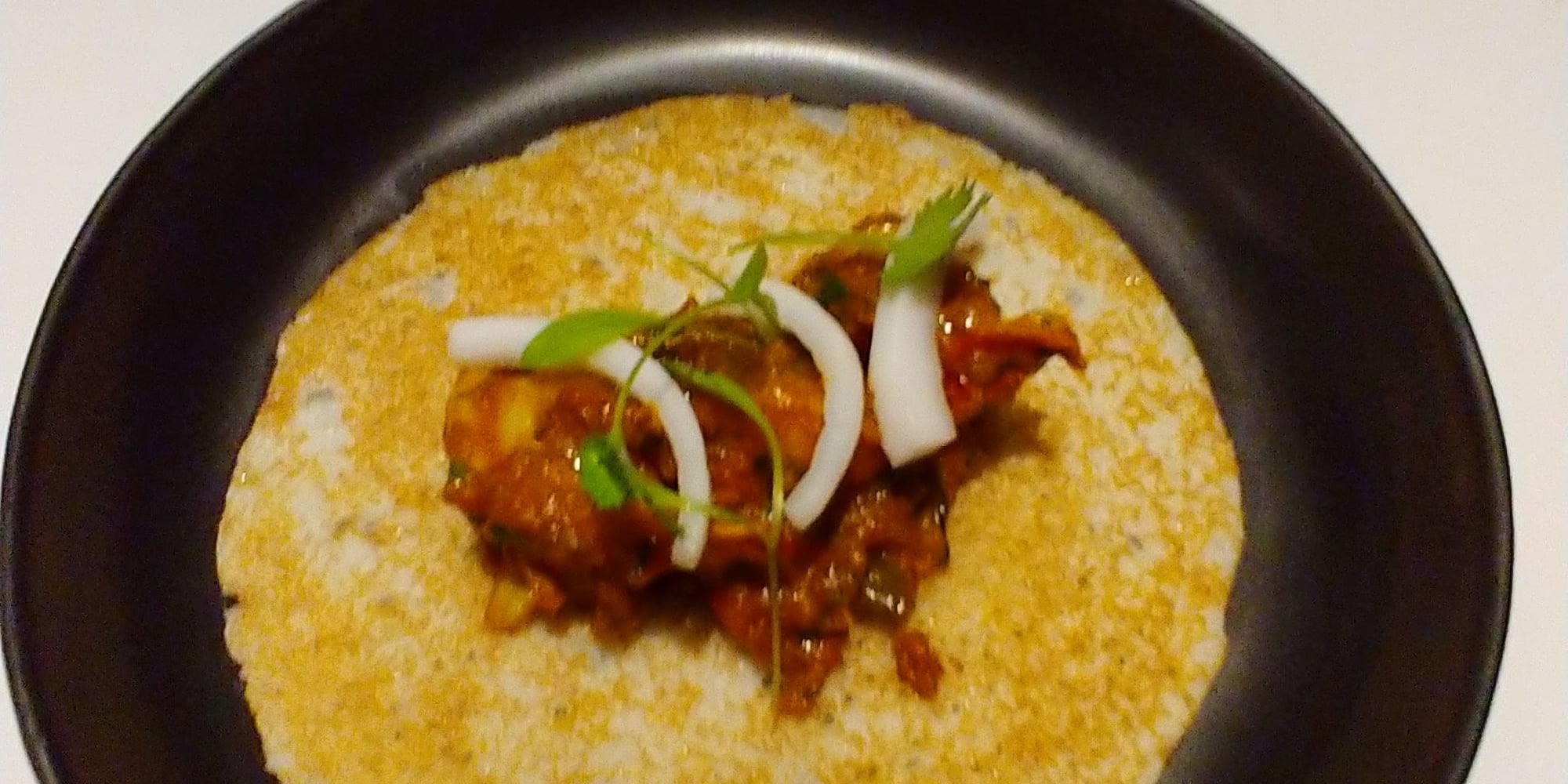
Course twenty-two had a rose emoji. My notes are a little off here because the plating was impressive. The server brought out two hollow books, and opened them two reveal two roses made of some sort of licorice on some sort of cookie. It was tasty and visually stunning.


Course twenty-three had a champagne emoji and consisted of a Chinese mooncake filled with a grape and Riesling syrup. The mooncake was made of coconut. The dish was served cold, and had a chewy texture. My wife did not care for the filling and noted that it tasted like artificial grape cough syrup. I didn’t mind it as much, but it was not one of our favorites.
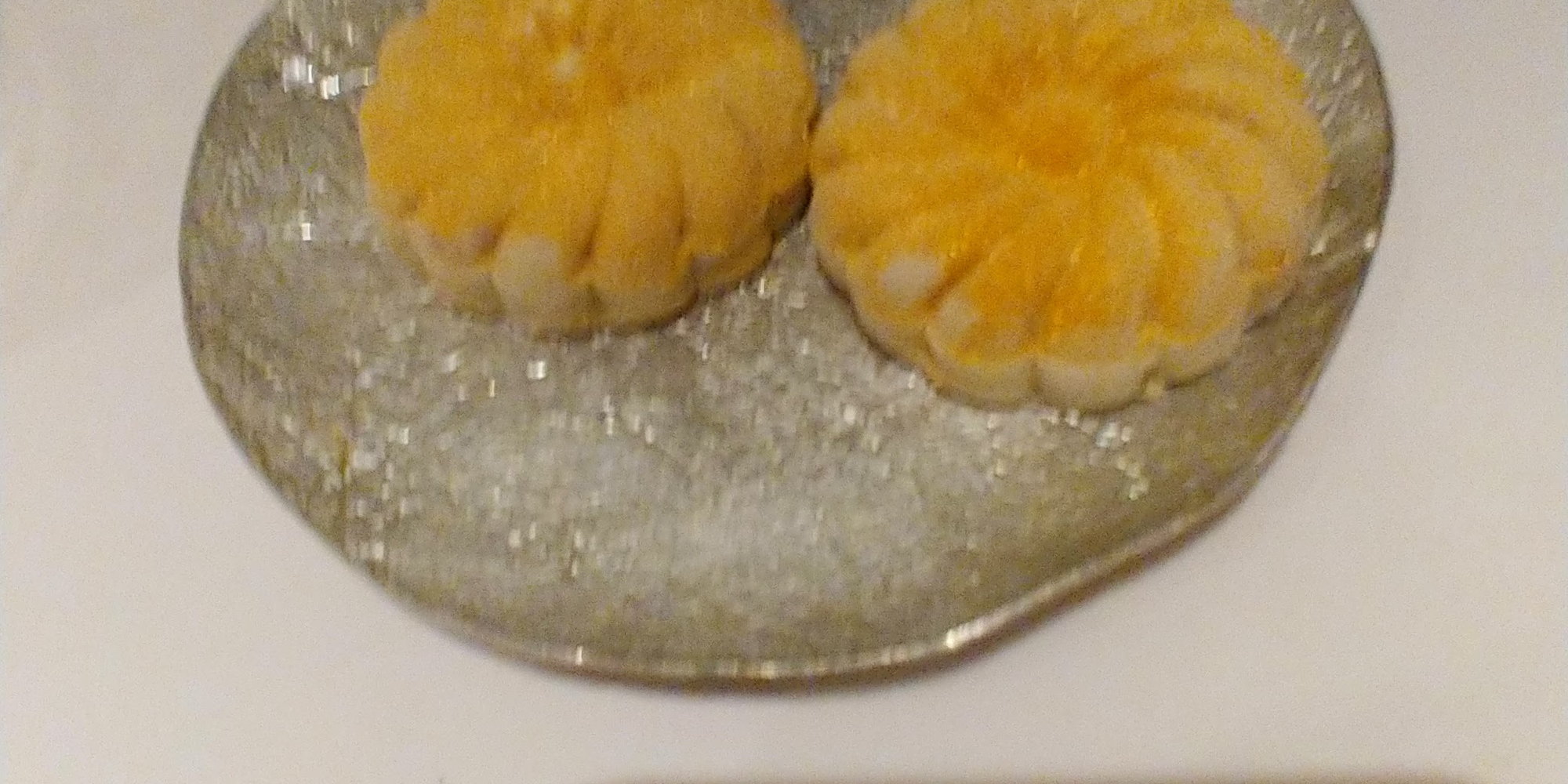
Course twenty-four had a lemon emoji and consisted of a coconut ricotta with yuzu white chocolate served on a stick, similar to a Mexican paleta or an ice cream bar. Ricotta and chocolate were prevalent on the front, with the yuzu coming up towards the back.
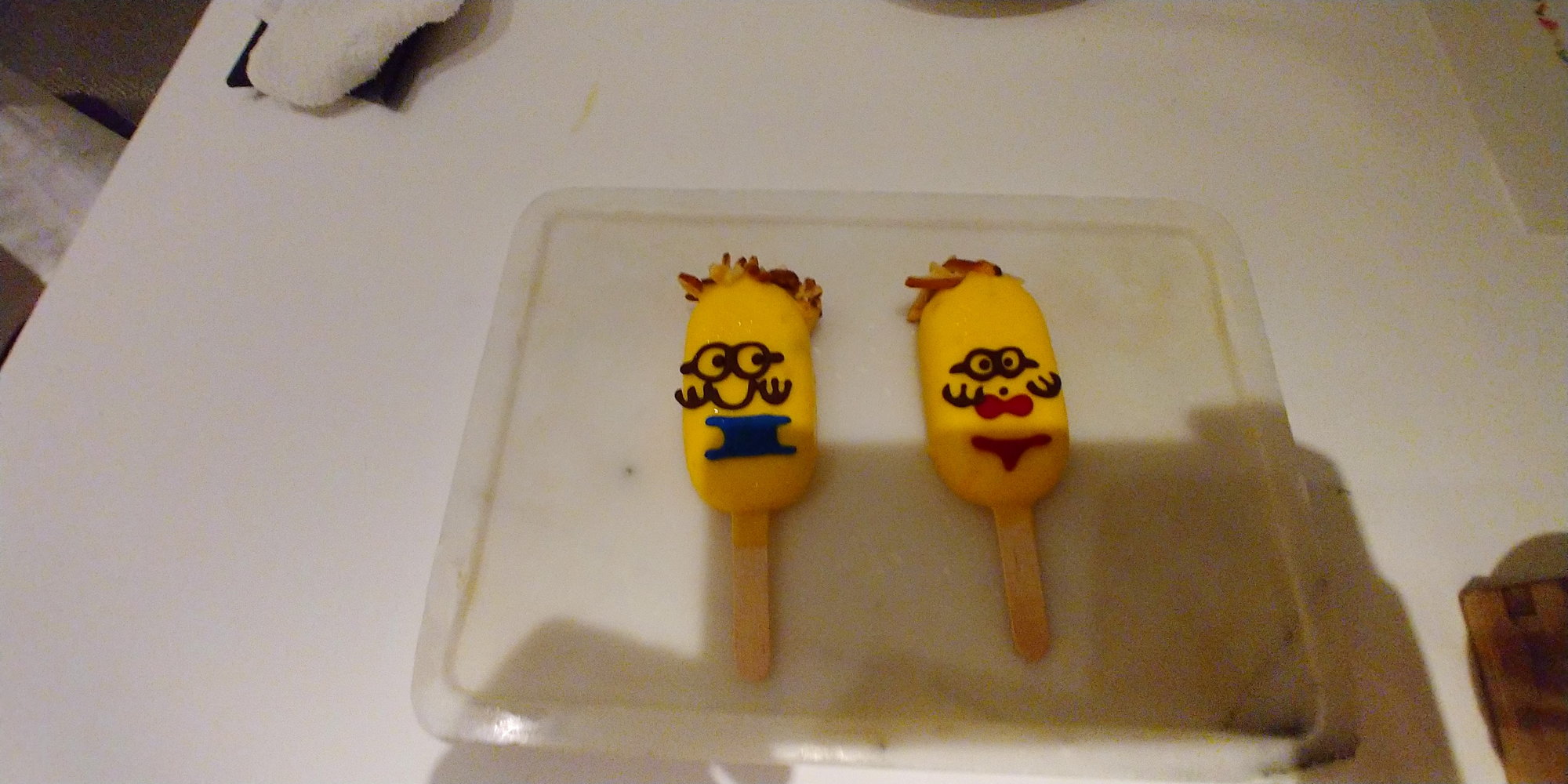
Course twenty-five had an Indian flag emoji and was a “taste of India”. It consisted of a rice cracker with spiced mango.
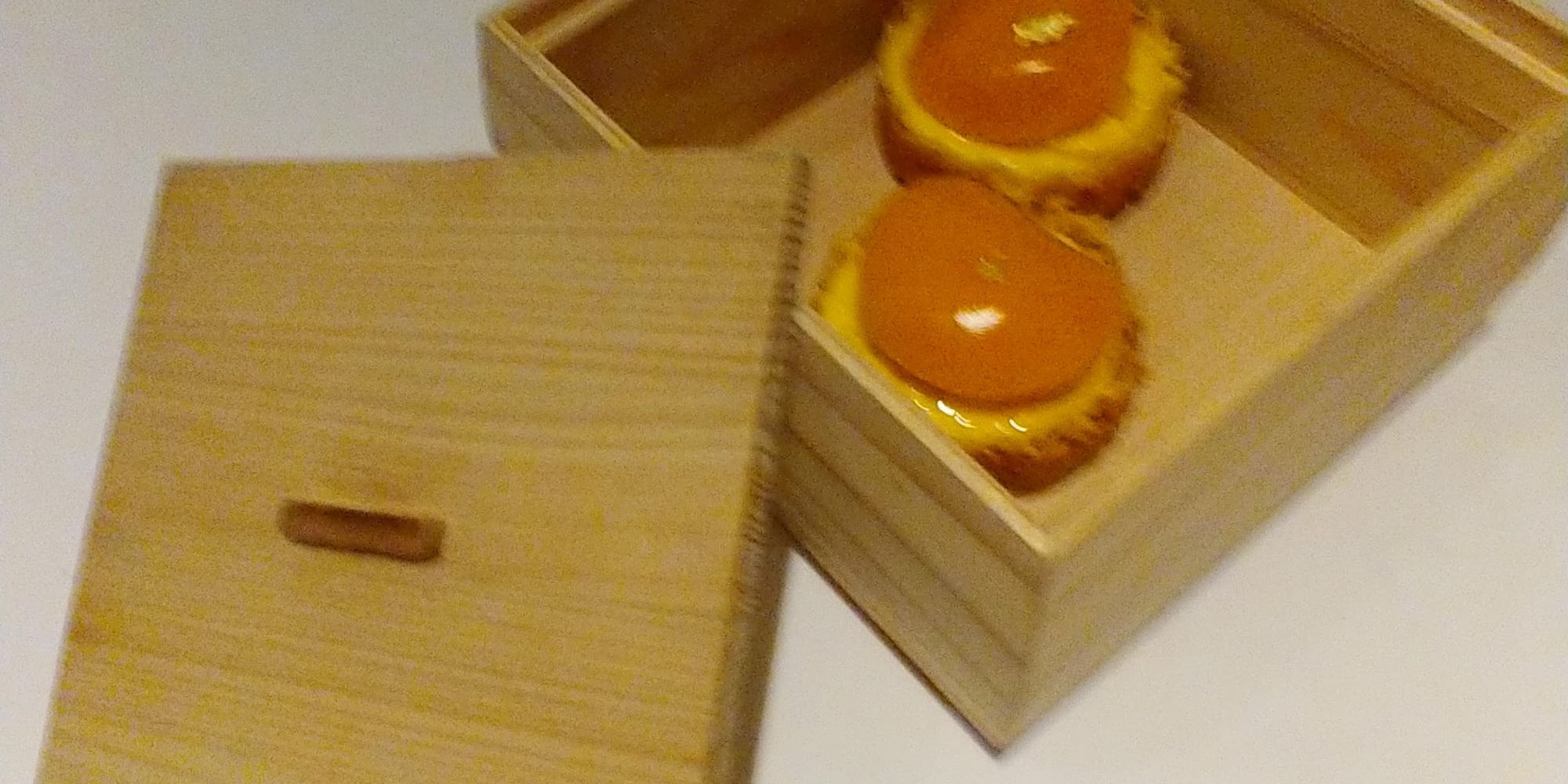
Somewhere around the fifteenth course, we finished our wine and decided to get some cocktails. My wife ordered a “smokin’” old fashioned, and I ordered the coconut lassi (gin based I believe). The presentation was impressive. My wife’s drink came covered with a glass dome to seal in the smoke. My drink was served in a coconut, sitting on a wooden box, filled with dry ice. Both drinks were delicious.


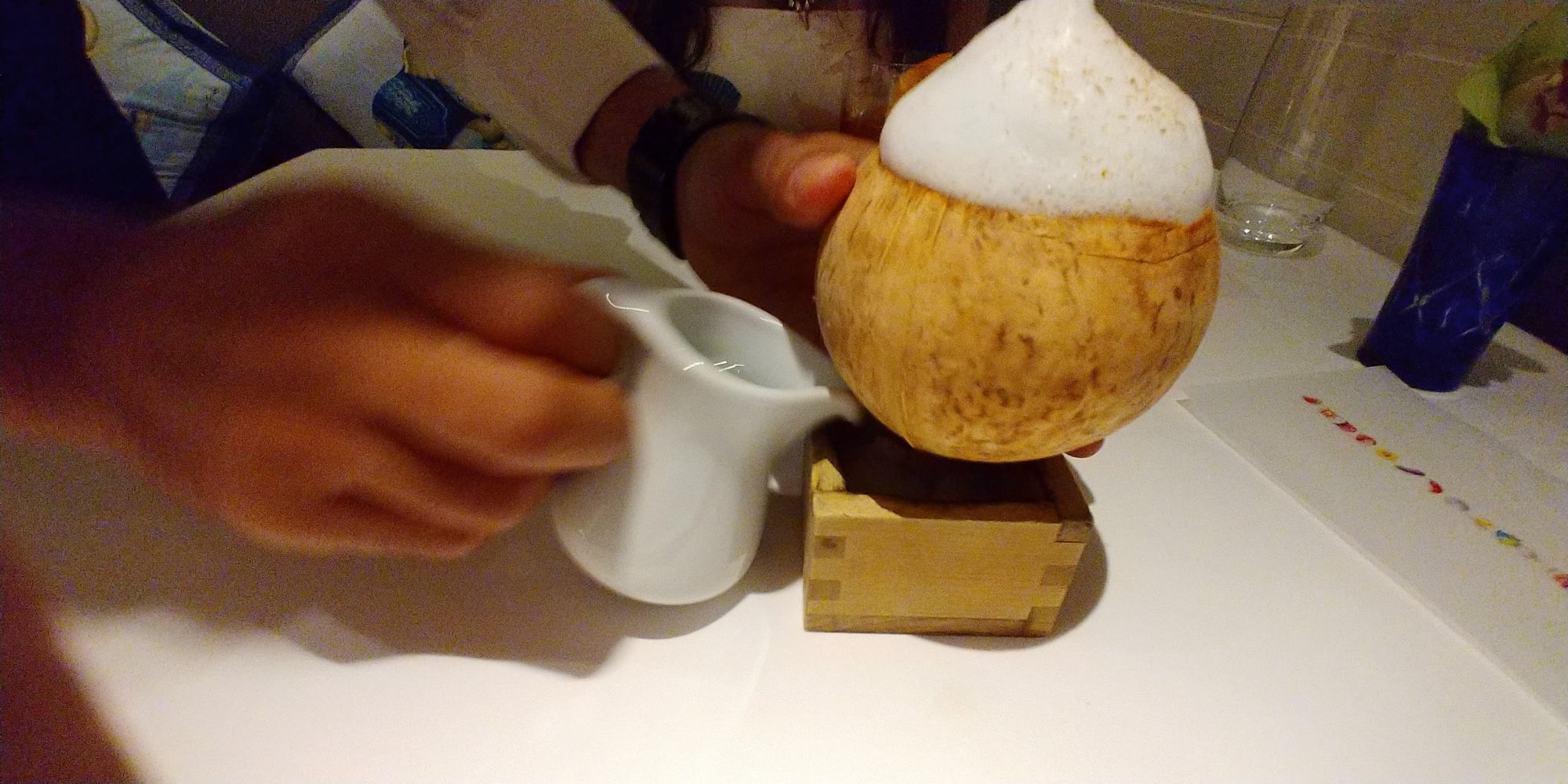


Service throughout the meal was spot on, with servers constantly filling our glasses, making small talk, and overall being very attentive. At the end of the meal, the servers brought over a second
menu for us to keep. This one had a one or two word summary accompanying the emojis, to help remind the diner what they ate.
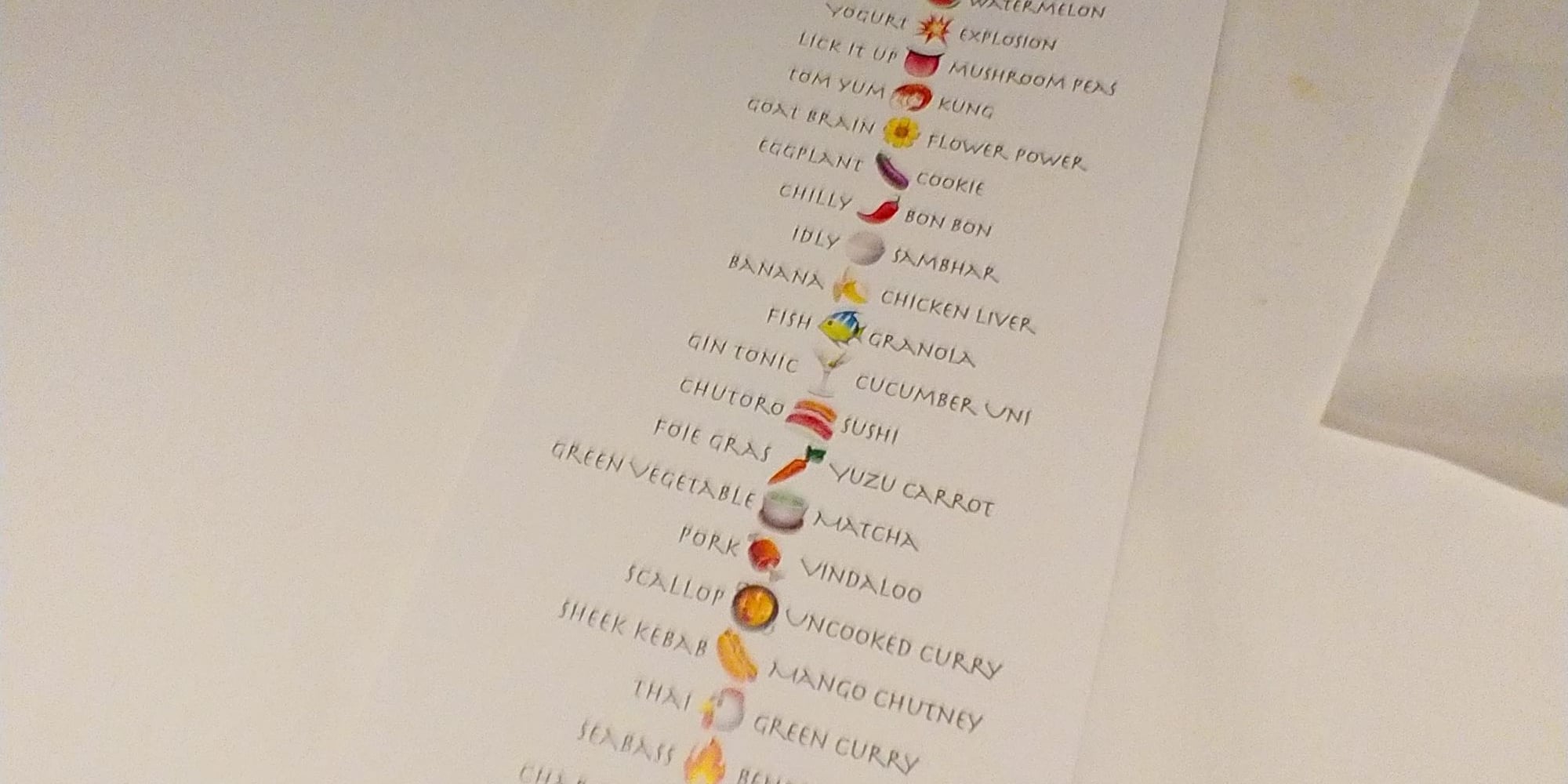
In sum, I think what I found most impressive was the amount of flavor Gaggan was able to pack into such small bites. We left incredibly full, and for the price, you can’t beat the value. Overall, Gaggan is an excellent restaurant, and definitely the highlight of our time in Bangkok. I can’t wait to see how he does when he moves to Tokyo.
Following our dinner, we retired for the night, our stomachs full, and hearts brimming with anticipation as we headed the next day to Amanpuri. Paradise awaited us.